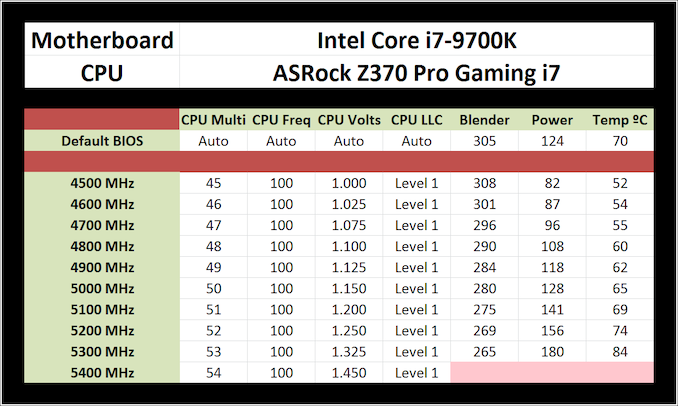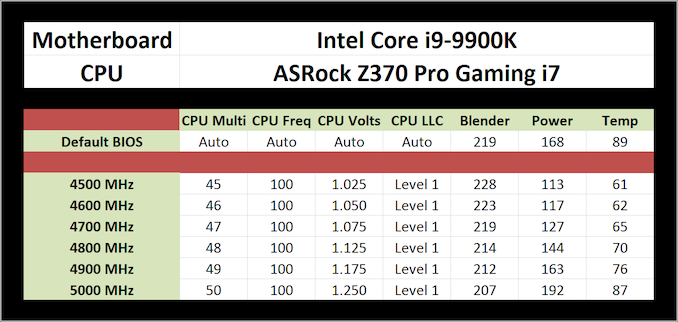The Intel 9th Gen Review: Core i9-9900K, Core i7-9700K and Core i5-9600K Tested
by Ian Cutress on October 19, 2018 9:00 AM EST- Posted in
- CPUs
- Intel
- Coffee Lake
- 14++
- Core 9th Gen
- Core-S
- i9-9900K
- i7-9700K
- i5-9600K
Overclocking
With the upgraded thermal interface between the processor and the heatspreader, from paste to solder, Intel is leaning on the fact that these overclockable processors should be more overclockable than previous generations. We’ve only had time to test the Core i9-9900K and i7-9700K on this, so we took them for a spin.
Our overclocking methodology is simple. We set the Load Line Calibration to static (or level 1 for this ASRock Z370 motherboard), set the frequency to 4.5 GHz, the voltage to 1.000 volts, and run our tests. If successfully stable, we record the power and performance, and then increase the CPU multiplier. If the system fails, we increase the voltage by +0.025 volts. The overclocking ends when the temperatures get too high (85C+).
For our new test suite comes new overclocking features. As mentioned in the previous page, our software loading for power measurement is POV-Ray, which can thrash a processor quite harshly. POV-Ray also does a good job on stability, but is not a substantial enough test – for that we use our Blender workload, which pushes the cores and the memory, and lasts about 5 minutes on an 8 core processor.
Results as follows:
For the Core i7-9700K, we hit 5.3 GHz very easily, for a small bump in power and temperature. For 5.4 GHz, we could boot into the operating system but it was in no way stable – we were ultimately voltage/temperature limited at this case. But an eight core, eight thread 5.3 GHz CPU at 180W for $374? Almost unimaginable a year ago.
Overclocking the Core i9-9900K was not as fruitful. The best bit about this overclock is the 4.7 GHz value: by using our own voltage settings, we reduced power consumption by 41W, almost 25% of the total power, and also reduced temperatures by 24ºC. That's a safe idea. Even 4.8 GHz and 4.9 GHz was reasonable, but the temperatures at 5.0 GHz might not be for everyone. When all cores and threads are loaded, this is one warm chip.












274 Comments
View All Comments
Ian Cutress - Monday, October 22, 2018 - link
Emn13: Base code with compiler optimizations only, such as those a non-CompSci scientist would use, as was the original intention of the 3DPM test, vs hand tuned AVX/AVX2/AVX512 code.just4U - Saturday, October 20, 2018 - link
The only problem I really have with the product is for the price it should have come with a nice fancy cooler like the 2700x which is in it's own right a stellar product at close to 60% of the cost. Not sure what intel's game plan is with this but It's priced close to a second gen entry threadripper and for it's cost you might as well just make the leap for a little more.khanikun - Monday, October 22, 2018 - link
I'm the other way. I'd much rather they lower the cost and have no cooler. Although, Intel doesn't decrease the cost without the cooler, which sucks.I'm either getting a new waterblock or drilling holes in the waterblock bracket to make it fit. Well I just upgraded, so I'm not in the market for any of these procs.
brunis.dk - Saturday, October 20, 2018 - link
no prayers for AMD?ingwe - Friday, October 19, 2018 - link
I don't see the value in it though I understand that this isn't sold as a value proposition--it is sold for performance. Seems to do the job it sets out to do but isn't spectacularly exciting to me.jospoortvliet - Saturday, October 20, 2018 - link
Given how the quoted prices ignore the fact that right now Intel CPU prices art 30-50% higher than MSRP, yes, nobody thinking about value for money buys these...DanNeely - Friday, October 19, 2018 - link
Seriously though, I'm wondering about the handful of benchmarks that showed the i7 beating the i9 by significant amounts. 1-2% I assume is sampling noise in cases where the two are tied, but flipping through the article I saw a few where the i7 won by significant margins.Ian Cutress - Friday, October 19, 2018 - link
Certain benchmarks seem to be core-resource bound. In HT mode, certain elements of the core are statically partitioned, giving each thread half, and if only one thread is there, you still only get half. With no HT, a thread gets the full core to work with.0ldman79 - Friday, October 19, 2018 - link
I'd love to see some low level data on the i5 vs i7 on that topic.If the i5 is only missing HT then the i7 without HT should score identically (more or less) with the i5 winning on occasion vs the HT enabled i7. I always figured there was a significant bit of idle resources (ALU pipelines) in the i5 vs the i7, HT allowed 100% (or as close as possible) usage of all of the pipelines.
I wish Intel would release detailed info on that.
abufrejoval - Friday, October 19, 2018 - link
Well I guess you should be able to measure, if you have the chips. My understanding has alway been, that i7/i5 differentiation is all about voltage levels with i5 parts needing too much voltage/power to pass the TDP restrictions rather than defective logic precluding the use of 'one hyperthread'. I find it hard to imagine managing defects via partitions in the register file or by disabling certain ALUs: If core CPU logic is hit with a defect it's dead, because you can't isolate and route around the defective part at that granularity. It's the voltage levels on the long wires that determine a CPUs fate AFAIK.It's a free choice between a lower clock and HT or the higher clock without HT at the binning point and Intel will determine the fate of a chips on sales opportunities rather than hardware. And it's somewhat similar with the fully enabled lower power -T parts and the high-frequency -K parts, which are most likely the same (or very similar) top tier bins, sold at two distinct voltage levels yet rather similar premium prices, because you trade power and clocks and pay premium for efficiency.
Real chips defects can only be 'compensated' via cutting off cache blocks or whole cores, but again I'd tend to think that even that will be more driven by voltage considerations than 'hairs in the soup': With all this multi-patterning and multi-masking going on and the 3D structures they are lovingly creating for every FinFeT their control over the basic structures is so great, that it's mainly the layer alignment/conductivity that's challenging the yields.